Related Research Articles

The Piccadilly line is a deep-level London Underground line running from the north to the west of London. It has two branches, which split at Acton Town, and serves 53 stations. The line serves Heathrow Airport, and some of its stations are near tourist attractions such as Piccadilly Circus and Buckingham Palace. The District and Metropolitan lines share some sections of tracks with the Piccadilly line. Printed in dark blue on the Tube map, it is the fourth-busiest line on the Underground network with over 210 million passenger journeys in 2011/12.
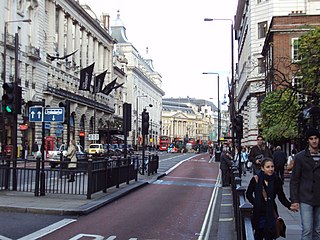
Piccadilly is a road in the City of Westminster, London, to the south of Mayfair, between Hyde Park Corner in the west and Piccadilly Circus in the east. It is part of the A4 road that connects central London to Hammersmith, Earl's Court, Heathrow Airport and the M4 motorway westward. St James's is to the south of the eastern section, while the western section is built up only on the northern side. Piccadilly is just under 1 mile (1.6 km) in length, and it is one of the widest and straightest streets in central London.
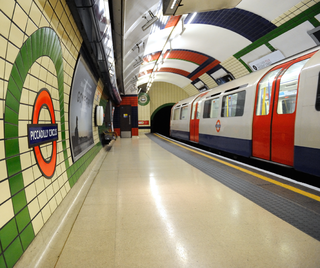
Piccadilly Circus is a London Underground station located directly beneath Piccadilly Circus itself, with entrances at every corner. Located in Travelcard Zone 1, the station is on the Piccadilly line between Green Park and Leicester Square and on the Bakerloo line between Charing Cross and Oxford Circus.

Kensington Gore is the name of a U-shaped thoroughfare on the south side of Hyde Park in central London, England. The streets connect the Royal Albert Hall with the Royal College of Art, the Royal Geographical Society, and in Kensington Gardens the Albert Memorial. The area is named after the Gore estate which occupied the site until it was developed by Victorian planners in the mid 19th century. A gore is a narrow, triangular piece of land, in this case
the wedge-shaped piece of land which divides them, and which has been known from Anglo-Saxon times as The Gore.

Pall Mall is a street in the St James's area of the City of Westminster, Central London. It connects St James's Street to Trafalgar Square and is a section of the regional A4 road. The street's name is derived from pall-mall, a ball game played there during the 17th century, which in turn is derived from the Italian pallamaglio, literally ball-mallet.
Sir James Pennethorne was a British architect and planner, particularly associated with buildings and parks in central London.

St James's is a central district in the City of Westminster, London, forming part of the West End. In the 17th century the area developed as a residential location for the British aristocracy, and around the 19th century was the focus of the development of gentlemen's clubs. Once part of the parish of St Martin in the Fields, much of it formed the parish of St James from 1685 to 1922. Since the Second World War the area has transitioned from residential to commercial use.

Jermyn Street is a one-way street in the St James's area of the City of Westminster in London, England. It is to the south of, parallel, and adjacent to Piccadilly. Jermyn Street is known as a street for gentlemen's-clothing retailers.
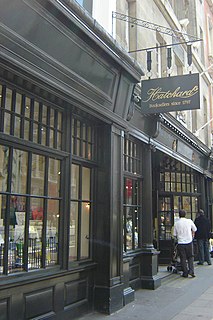
Hatchards is a branch of Waterstones, and claims to be the oldest bookshop in the United Kingdom, founded on Piccadilly in 1797 by John Hatchard. After one move, it has been at the same location on Piccadilly next to Fortnum & Mason since 1801, and the two stores are also neighbours in St. Pancras railway station as of 2014. It has a reputation for attracting high-profile authors and holds three Royal Warrants granted by the Queen, the Prince of Wales and the Duke of Edinburgh respectively.

Coventry Street is a short street in the West End of London, connecting Piccadilly Circus to Leicester Square. Part of the street is a section of the A4, a major road through London. It is named after the politician Henry Coventry, secretary of state to Charles II.
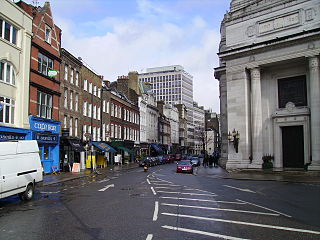
Great Queen Street is a street in the West End of central London in England. It is a continuation of Long Acre from Drury Lane to Kingsway. It runs from 1 to 44 along the north side, east to west, and 45 to about 80 along the south side, west to east. The street straddles and connects the Covent Garden and Holborn districts and is in the London Borough of Camden. It is numbered B402.

The Royal Institute of Painters in Water Colours (RI), initially called the New Society of Painters in Water Colours, is one of the societies in the Federation of British Artists, based in the Mall Galleries in London.

The Naval and Military Club, known informally as The In & Out, is a private members club located in St James's Square, London. It was founded in 1862 for gentlemen of the British Armed Forces. It now also accepts female members, and members who have not served in the armed forces, but continues to observe service traditions.

St James's Street is the principal street in the district of St James's, central London. It runs from Piccadilly downhill to St James's Palace and Pall Mall. The main gatehouse of the Palace is at the southern end of the road; in the 17th century, Clarendon House faced down the street across Piccadilly from the site of what is now Albemarle Street.

Cambridge House is a Grade I listed former townhouse in central London, England. It sits on the northern side of Piccadilly at number 94, in the fashionable district of Mayfair. As of 2021, the property is being converted into a luxury hotel and seven residences.

The Geological Museum, started in 1835 as one of the oldest single science museums in the world and now part of the Natural History Museum in London. It transferred from Jermyn Street to Exhibition Road, South Kensington in 1935 in a building designed by Sir Richard Allison and John Hatton Markham of the Office of Works.

Dover Street is a street in Mayfair, London. The street is notable for its Georgian architecture as well as the location of historic London clubs and hotels, which have been frequented by world leaders and historic figures in the arts. It also hosts a number of contemporary art galleries. An equestrian sculpture by Elisabeth Frink stands on the junction of Dover Street and Piccadilly, opposite the Ritz Hotel.

Piccadilly Arcade runs between Piccadilly and Jermyn Street in central London. It was opened in 1909, having been designed by Thrale Jell, and is a Grade II listed building.
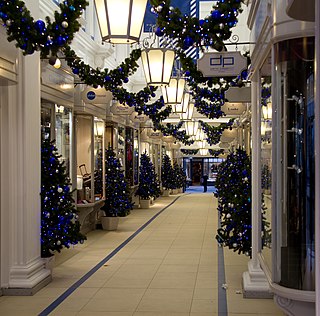
Princes Arcade is an arcade of shops running between Piccadilly and Jermyn Street in central London. It is home to a number of small menswear shops and boutiques.

Mount Street is an east–west, quite narrow, archetypal street in the Mayfair district of the City of Westminster, London fronted by many mid-rise buildings, mostly of a narrow frontage. The sides of two very grand hotels flank part of either end of the street. Small, high-end property businesses, investment funds and accountancy businesses punctuate the buildings as well as a row of traditional businesses and conversion-style mansion block apartments or, more generally, authentic such homes.
References
- ↑ "Prince's Hall, Piccadilly Street in London" Central Online Victorian Educator. Retrieved 31 October 2020.
- 1 2 'Piccadilly, South Side', in Survey of London: Volumes 29 and 30, St James Westminster, Part 1, ed. F H W Sheppard (London, 1960) British History Online. Retrieved 30 October 2020.
- 1 2 Historic England. "Former Royal Institute of Painters in Water Colours, now forming part of Prince's House (1265805)". National Heritage List for England . Retrieved 30 October 2020.
Coordinates: 51°30′30.9″N0°8′15.7″W / 51.508583°N 0.137694°W